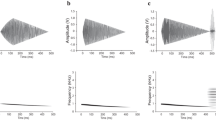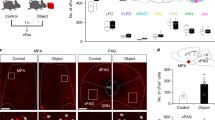Abstract
To examine the effects of vomeronasal deprivation on strike-induced chemosensory searching (SICS) in rattlesnakes we used a newly developed technique to anesthetize the vomeronasal organs. We compared rate of tongue flicking after striking prey in avomic rattlesnakes to vomic controls. Avomic rattlesnakes exhibited significantly fewer tongue flicks after striking prey than did vomic controls. However, avomic subjects still exhibited a significantly higher rate of tongue flicking (RTF) than did subjects that were presented with prey but not allowed to strike indicating that the increase in RTF seen in avomic snakes reflects a component of predatory behavior that is released by the strike and not dependent upon further vomeronasal activation. A second experiment was conducted to examine the role of the vomeronasal system (VNS) in location of envenomed prey. Disruption of the VNS chemoreception significantly reduced the number of poststrike tongue flicks, significantly increased the latency to locate the prey item and significantly increased the latency to commence swallowing the prey item, indicating that normal expression of these behaviors is dependent upon a functioning vomeronasal system.
Similar content being viewed by others
References
ALI, C. N., LAUNDL, T. M., WALLACE, K. L., SHAW, D. W., DECARLE, D. J., & COOK, I. J. (1994). Influence of mucosal receptors on deglutitive regulation of pharyngeal and upper esophageal sphincter function. American Journal of Physiology-Gastrointestinal and Liver Physiology, 267, 4, 644–649.
ALVING, W. R., & KARDONG, K. V. (1996). The role of the vomeronasal organ in rattlesnake (Crotalus viridis oreganus) predatory behavior. Brain Behavior & Evolution, 48, 165–172.
ANDREN, C. (1982). The role of the vomeronasal organs in the reproductive behavior of the adder Vipera berus. Copeia, 1, 148–157.
BARLOW, G. W. (1977). Modal action patterns. In J. Sebeok (Ed.), How animals communicate (pp. 98–134). Bloomington: Indiana University Press.
BURGHARDT, G. M. (1970). Chemical perception in reptiles. In J. W. Johnston, D. G. Moulton, & A. Turk (Eds.), Advances in chemoreception. I. Communication by chemical signals (pp. 241–308). New York: Appleton-Century-Crofts.
BURGHARDT, G. M. (1980). Behavioral and stimulus correlates of vomeronasal functioning in reptiles: Feeding, grouping, sex, and tongue use. In D. Duvall, D. Muller-Schwarz, & R. M. Silverstein (Eds.), Chemical signals of vertebrates and aquatic invertebrates (pp. 275–301). New York: Plenum Press.
BURGHARDT, G. M. (1983). Aggregation and species discrimination in newborn snakes. Zeitschrift für Tierpsychology, 61, 89–101.
CHISZAR, D. (1986). Motor patterns dedicated to sensory functions. In D. Duvall, D. Muller-Schwarz, & R. M. Silverstein (Eds.), Chemical signals in vertebrates 4 (pp. 37–44). New York: Plenum Press.
CHISZAR, D., & RADCLIFFE, C. W. (1976). Rate of tongue flicking by rattlesnakes during successive stages of feeding on rodent prey. Bulletin of the Psychonomic Society, 7, 485–486.
CHISZAR, D., RADCLIFFE, C. W., & SCUDDER, K. M. (1977). Analysis of the behavioral sequence emitted by rattlesnakes during feeding episodes. Behavioral Biology, 21, 418–425.
CHISZAR, D., RADCLIFFE, C. W., & SMITH, H. M. (1978). Chemosensory searching for wounded prey by rattlesnakes is released by striking: A replication report. Herpetological Review, 9, 54–56
CHISZAR, D., RADCLIFFE, C. W., O’CONNELL, B., & SMITH, H. M. (1981). Strike-induced chemosensory searching in rattlesnakes (C. viridis) as a function of disturbance prior to presentation of rodent prey. The Psychological Record, 31, 57–62.
DE COCK BUNNING, T. (1983). Thermal sensitivity as a specialization for prey capture and feeding in snakes. American Zoology, 23, 363–375.
DICKMAN, D. J., COLTON, J. S., CHISZAR, D., & COLTON, C. A. (1987). Trigeminal responses to thermal stimulation of the oral cavity in rattlesnakes (Crotalus viridis) before and after bilateral anesthetization of the facial pit organs. Brain Research, 400, 365–370.
DULLEMEIJER, P. (1961). Some remarks on the feeding behavior of rattlesnakes. Koninklijke Nederlandische Akademie von Wetenschappen, Series C, 64, 383–396.
DUVALL, D., SCUDDER, K. M., & CHISZAR, D. (1980). Rattlesnake predatory behavior: Mediation of prey discrimination and release of swallowing by odors associated with envenomated mice. Animal Behaviour, 28, 674–683.
ESTEP, K., POOLE, T., RADCLIFFE, C. W., O’CONNELL, B., & CHISZAR, D. (1981). Distance traveled by mice (Mus musculus) after envenomation by prairie rattlesnakes (Crotalus viridis viridis). Bulletin Psychonomic Society, 18, 108–110.
GANS, C. (1966). The biting behavior of solenoglyph snakes—Its bearing on the pattern of envenomation. Proceedings of the International Symposium on Venomous Animals. Sao Paulo, Brazil: Instituto Butantan.
GOLAN, L., RADCLIFFE, C., MILLER, T., O’CONNELL, B., & CHISZAR, D. (1982). Trailing behavior in prairie rattlesnakes (Crotalus viridis). Journal of Herpetology, 16, 287–293.
GRAVES, B. M., & DUVALL, D. (1985). Avomic prairie rattlesnakes (Crotalus viridis) fail to attack rodent prey. Zeitschrift für Tierpsychology, 67, 161–166.
GRAVES, B. M., & HALPERN, M. (1989). Chemical access to the vomeronasal organs of the lizard Chalcides ocellsatus. Journal of Experimental Zoology, 249, 150–157.
GRAVES, B. M., & HALPERN, M. (1990). Roles of vomeronasal organ chemoreception in tongue flicking, exploratory and feeding behavior of the lizard Chalcides ocellsatus. Animal Behavior, 39, 692–698.
HALPERN, M. (1992). Nasal chemical senses in reptiles. In C. Gans & D. Crews (Eds.), Hormones, brain and behavior: Biology of the Reptilia Vol. 18 (pp. 423–523). Chicago: University of Chicago Press.
HALPERN, M., & FRUMIN, N. (1979). Roles of the vomeronasal and olfactory organs in prey attack and feeding in adult garter snakes. Physiology & Behavior, 22, 1183–1189.
HALPERN, M., & KUBIE, J. L. (1980). Chemical access to the vomeronasal organs of garter snakes. Physiology & Behavior, 24, 367–371.
HALPERN, M., & KUBIE, J. L. (1983). Snake tongue flicking behavior: Clues to vomeronasal system functions. In R. M. Silverstein & D. Muller-Schwarze (Eds.), Chemical signals in vertebrates 3 (pp. 45–72). New York: Plenum Publishing.
HALPERN, M., & KUBIE, J. L. (1984). The role of the ophidian vomeronasal system in species-typical behavior. Trends in Neuroscience, 7, 472–477.
KAHMANN, H. (1932). Sinnesphysiologische studien an reptilien: I. Experimentalle unterswuchungen uber das jakobsonche organ der eideschen und schlangen. Zool. Jhb. Zoological Physiology, 51, 173–238.
KAHMANN, H. (1934). Zur Chemorezeption der Schlangen (ein Nachtag). Zool. Anz., 107, 249–263.
KARDONG, K. (1986). Predatory strike behavior of the rattlesnake (Crotalus v. oreganus). Journal of Comparative Psychology, 100, 304–314.
KARDONG, K. V. (1992). Proximate factors affecting guidance of the rattlesnake strike. Zool. Jb. Anatated., 122, 233–244.
KUBIE, J. L., & HALPERN, M., (1979). Chemical senses involved in garter snake prey trailing. Journal of Comparative Physiological Psychology, 93, 648–667.
LORENZ, K. Z. (1981). The foundations of ethology. New York: Springer-Verlag.
MANSSON, I., & SANDBERG, N. (1974). Effects of surface anesthesia on deglutition in man. Laryngoscope, 84, 3, 427–437
MELCER, T., & CHISZAR, D. (1989) Striking prey creates a specific chemical search image in rattlesnakes. Animal Behavior, 37, 477–486.
NEWMAN, E., & HARTLINE, P. (1981). Integration of visual and thermal information in bimodal neurons of the rattlesnake optic tectum. Science, 213, 789–791.
NEWMAN, E., & HARTLINE, P. (1982). The infrared “vision” of snakes. Scientific American, 246, 116–127.
O’CONNELL, B. R., GREENLEE, J., BACON, J., & CHISZAR, D. (1982). Strike-induced chemosensory searching in old world vipers and new world pit vipers at San Diego Zoo. Zoo Biology, 1, 287–294
RADCLIFFE, C. W., CHISZAR, D., & O’CONNELL, B. (1980). Effects of prey size on post strike behavior in rattlesnakes. Bulletin of the Psychonomic Society, 16, 449–450.
SCUDDER, K. M., CHISZAR, D., & SMITH, H. M. (1983). Effect of environmental odors on strike induced chemosensory searching by rattlesnakes. Copeia, 1983, 519–522.
SHINE, R., PHILLIPS, B., WAYE, H., LEMASTER, M., & MASON, R. T. (2003). Chemosensory cues allow courting male garter snakes to assess body length and body condition of potential mates. Behavioral Ecology and Sociobiology, 54, 162–166
TINBERGEN, N. (1951). The study of instinct. Oxford: Oxford University Press.
YOUNG, B. A. (1993). Evaluating hypotheses for the transfer of stimulus particles to Jacobson’s organ in snakes. Brain Behavior & Evolution, 41, 203–209.
Author information
Authors and Affiliations
Corresponding author
Rights and permissions
About this article
Cite this article
Stark, C.P., Chiszar, D. & Smith, H.M. A Noninvasive Technique for Blocking Vomeronasal Chemoreception in Rattlesnakes. Psychol Rec 56, 471–487 (2006). https://doi.org/10.1007/BF03396028
Published:
Issue Date:
DOI: https://doi.org/10.1007/BF03396028




